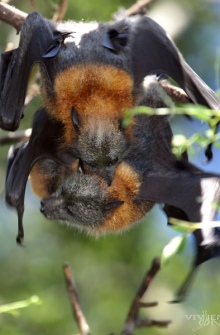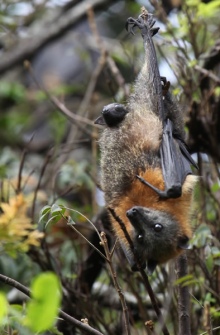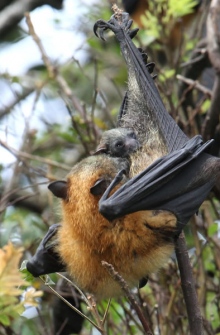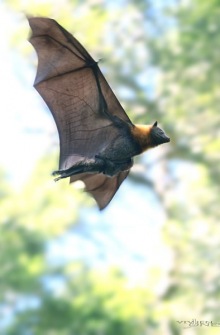Reproduction
Mating
- Males are sexually mature by 30 months and females by age two.
- From January each mature male marks his territory in a tree with secretions from scent gland on his shoulders. He defends it vigorously from other males with wing-spreading threat displays and loud calls.
- Females chose a male, and may stay with him for weeks or only a few days.
- If a female moves to another camp where food is more plentiful, she will roost in the territory of a male.
- Mating behavior begins in January – February and continues through to April – May when conception occurs.
- Flying-foxes do not form lifelong relationships.
Find out more about flying-fox sex from a program broadcast on The Science Show (Radio National) in which Dr Peggy Eby was interviewed.
Birth
- After 6 months gestation, females give birth to one pup in spring (mid September to November).
- Most give birth in the tree tops of the camp.
- First the head appears and the mother licks her pup.
- The female clings to branches with her thumbs and toes and forms a u-shaped body sling during the birth.
- Newborns are caught and supported until they get a good hold with their claws in her fur and hold on to a teat with their mouth.
- There is one teat beneath each wingpit.
- Newborn pups are well furred except on their tummy which is against mother’s body to keep warm.
- Their eyes are open.
- They weigh about 80grams , about 10% of mother’s weight.
Dependent on mothers milk
- A mother flying-fox protects her pup with her wings during the day and takes the infant clinging to her body while flying in search of food.
- Once pups are 15 -17 days old and able to regulate their own body temperature they are left overnight in the camp.
- Pups do not recognise their mothers but mothers identify them using smell and sound.
- At 10-14 weeks old they begin flying between trees within the camp.
- In January – February they begin flying out of the camp short distances with the adults.
- Pups begin to be weaned in late March and only a few are still suckling in early May.



